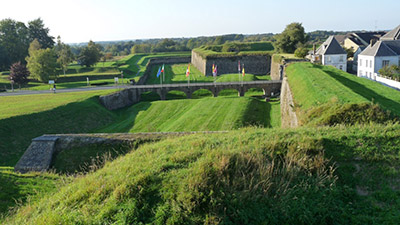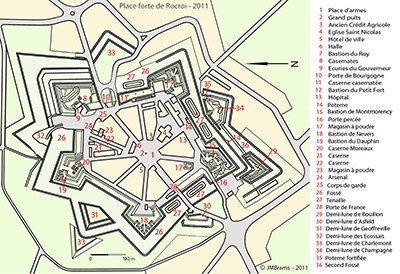 |
Rocroi
Ardennes, France
|
|
 |
Constructed: 1552 - 1556,
additions made until 1886
Used by: France, Spain
Conflict in which it participated:
30 Years' War
|
The lopsided starfort at Rocroi was part of a centuries-long chess match between France and Spain: You build a fort there, I respond with a bigger fort here.
In the 17th century, France was completely surrounded by either water or Habsburgs. Spain was of course to the south, but the Spanish Netherlands, which are today Belgium and the Netherlands, lurked threateningly to the north...and the lands of the Austrian branch of the Habsburg Empire were to the east.
|
 |
|
|
In 1552, Holy Roman Emperor Charles V (1500-1558) decreed that a fort shall be built at Givet, a town at the border of the Spanish Netherlands and France. This would be the Fort of Charlemont, which had starforty elements but was not a starfort. So we can stop talking about it now.
To counter this move, French King Henry II (1519-1559) ordered the fortification of Rocroi, less than 20 miles to Givet's southwest. A basioned trace, in the form of a rather drunken-looking pentagon, was thrown up around the town of Rocroi. The northernmost bastion, named Basion du Petit Fort (bastion of the little fort), was based on an earlier fortification. Which appears to have been little.
|
 Rocroi's front gate, inexplicably flying the flags of many nations Rocroi's front gate, inexplicably flying the flags of many nations
|
 |
French King Louis XIII died on May 14, 1643, leaving his 5-year-old heir, Louis XIV 1638-1715), to mind the shop. This occurred during the latter stages of the 30 Years' War (1618-1648), when things were getting desperate for France. Perhaps thinking that a five-year-old would now be personally leading France's armed forces, the Spanish army advanced over France's northern border to attack Rocroi, or more specifically to besiege the fortifications at Rocroi. |
|
The Spanish Tercio, an organized force of 3,000 pikemen, swordsmen and arquebusiers, were the terror of the 16th century European battlefield. These units were intended to fight in groups of three, hence the name Tercio. The Tercio would attack in a mutually supporting square, which made sense in an open field in the days when artillery was little more than an unwieldy pain in the ass for those employing it - but in a siege situation against an enemy with slightly more advanced artillery, the rigid formation of the Tercio became a liability.
|
The Battle of Rocroi, which took place on May 19, 1643, was the first major Spanish defeat in the 30 Years' War, and spelled the beginning of the end of both the Tercio and the Spanish Netherlands. The painting to the right depicts the bloodied last Spanish Tercio, pausing briefly before being driven from the field by French artillery and knights, led by the blood-crazed 5-year-old Louis XIV (not really).
The Battle of Rocroi marked the return of France to the international stage after a century of civil war and defeat. Can the starfort at Rocroi be given credit for this? Sure it can.
|
 |
Rocroi, el Último Tercio (Rocroi, the Last Third), painted in a most impressive manner in 2011 by Augusto Ferrer-Dalmau (1964- ) |
|
Despite this French victory, Spain managed to occupy Rocroi, without much in the way of French resistance, from 1653 to 1659. The Spanish considerately built two counterguards, advanced outerworks that protected bastions, while stewards of the fort.
|
 A lovely drawing of Rocroi from 2011. I can almost read French. A lovely drawing of Rocroi from 2011. I can almost read French. |
 |
Rocroi was returned to the French by the Treaty of the Pyrenees (1659), which ended the conflict betwixt France and Spain. Our Lord and Saviour Vauban (1633-1707) showed up and started doing his Vaubanny thing in 1675, causing a dizzying array of outerworks to be sprinkled around the fort for the next 25 years.
The pointily strengthened Rocroi became part of the second line of Vauban's Pré Carré, a system of fortifications along France's northern border. These defenses were intended to slow down an attacking enemy by forcing them into endless sieges of indestructible starforts. |
|
In 1706, Vauban wrote that he was pleased with the defenses at Rocroi, but that they were not finished. He made further plans of improvement, but once he died the following year everyone appears to have lost interest.
|
Further works were added to Rocroi in 1744 and 1838. Amazingly, improvements were still being made on the 300-year-old fort's walls between 1879 and 1886.
In 1886, however, an experiment was held at Fort Malmaison, a modern fort that was part of the Pré Carré's second line, in the town of Chavignon. Artillery shells with a new explosive compound called melanite were fired at the fort, in an effort to systematically determine the effect of the latest explosives on a masonry fortification.
|
 |
Looking into Rocroi from the Bastion de Montmorency, the fort's eastern bastion. |
|
As one might imagine, the masonry fortification did not fare well, although it was not given an opportunity to shoot back. This experiment led to the official determination that the concept of the masonry fort as a viable defense option was over. This became known as la Crise de l'Obus-Torpille, or Crisis of the Shell Torpedo...and was the final nail in the coffin of the starfort in the land of the starfort.
Today, the walls of Rocroi are there to be explored at will, except for some bastions and sections of the inner wall, which are private property. So watch it!
|
|
|
|
|
|
 |




